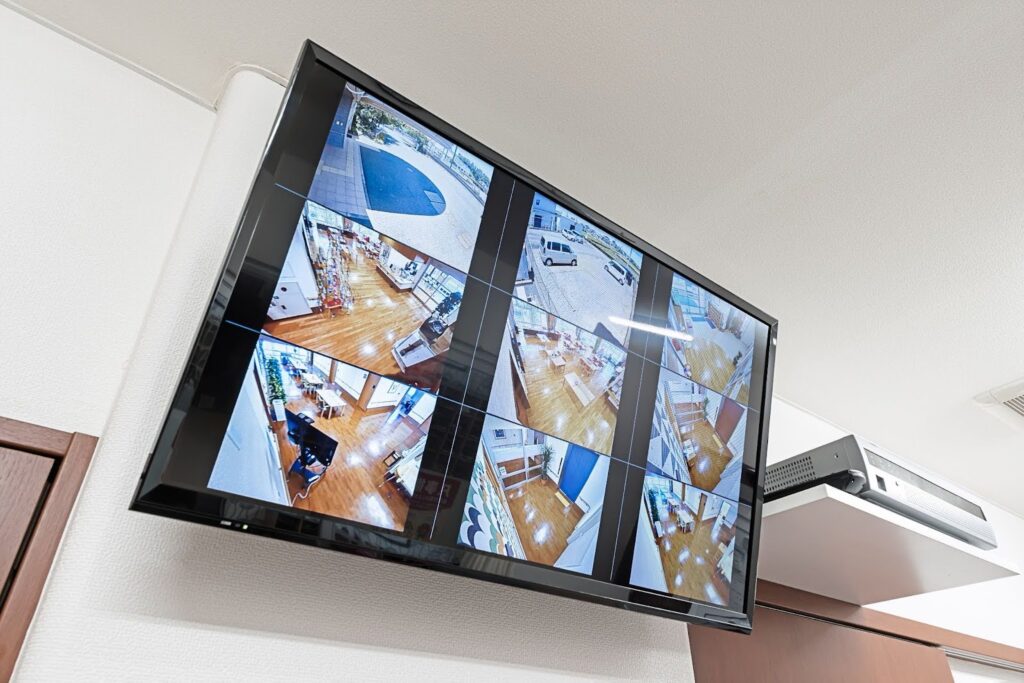
Restaurant Security Guards
Patrons of high-end restaurants want exceptional food, exceptional wine, and exceptional service. They also want to dine in a location that’s safe and free from distractions.
From stolen crystal and china to intoxicated and unruly customers, physical altercations, and guests who dine and dash, even the most upscale restaurants can fall prey to criminal activity.
Strong security measures protect your restaurant’s clientele and keep them coming back. Below, we provide a rundown of everything you need to know before you hire a high-end restaurant security guard.
1. Five Major Benefits of Hiring a Security Guard to Protect Your Restaurant
2. What Kind of Restaurant Security Guard Do You Need?
3. How to Find a Security Guard for Your Restaurant
Five Major Benefits of Hiring a Security Guard to Protect Your Restaurant
From crime prevention to staff safety, here are five key reasons to hire a security guard to protect your fine dining establishment.
Restaurant Security Guards Prevent Crime
When security guards are visible, they serve as crime deterrents. Criminals are more likely to target a restaurant without obvious security measures in place. The mere presence of a security guard is usually enough to convince bad actors to stay away.
Learn about other specialized security services:
Manufacturing plant security | celebrity security guards | yacht security | movie set security | event security | fire watch security | hospital security | bank security | movie theatre security
Although rare, some employees may be tempted to steal cash, alcohol, valuables, or employees’ and customers’ personal belongings. Having a security guard on site will make employees think twice before committing a crime.
Most security guards receive de-escalation training and know how to intervene peacefully during a fight. De-escalation is a crucial skill that can prevent a verbal argument between customers or staff from escalating into something more physical.
Security Services Promote a Peaceful and Secure Atmosphere
The mere presence of security personnel will create peace of mind for your diners and staff.
You can offer an extra level of security by stationing a guard in your parking lot. Exterior guards protect patrons’ cars from theft and vandalism. If necessary, they can escort customers or staff between the parking lot and restaurant.
Related: The Beginner’s Guide to Nightclub Security
 They Improve Access and Crowd Control
They Improve Access and Crowd Control
Front-entrance guards can double as bouncers who prevent unwanted guests from entering the premises.
This is a critical security measure for high-end establishments that require reservations or have strict dress codes. It’s also helpful for restaurants that have low occupancy levels and can’t run the risk of crowds.
Front-door guards are an absolute must for high-end restaurants that attract celebrity clientele or are run by celebrity chefs. If your restaurant often serves celebrity or VIP patrons, they’ll appreciate that you have someone there to guard the door.
In cities like Los Angeles and New York City, paparazzi and adoring fans can pose a danger to your celebrity or VIP guests and everyone inside. Guards can keep crowds at bay and usher them away from your property.
In the event that a restaurant patron attempts to “dine and dash,” security guards at the door can prevent them from leaving without paying for their meal.
Restaurant Security Supports Emergency Response
Professional security guards are responsible for creating and implementing emergency response plans. In the event of a kitchen fire or other crisis, security personnel can usher staff and customers to safety.
Security staff will also contact law enforcement in the event that police, fire and rescue, or emergency medical services are necessary.
Security Professionals Boost Customer Service
At many upscale restaurants, security officers pull double duty as customer service representatives. Restaurant customers often turn to guards to ask questions about the restaurant or get directions to the restroom, bar, or elevators.
By delivering friendly answers to such simple, common questions, guards can build a rapport with your clients to promote a better overall dining experience.
What Kind of Restaurant Security Guard Do You Need?
When hiring restaurant security services, think about how many guards you need, as well as the type of skills those guards should have. You’ll also need to consider what other, if any, security measures will be needed.
Armed vs Unarmed Guards
Some security guards have firearms training and a license to carry a gun and other weapons. Some do not. Whether you choose to hire armed or unarmed security guards is up to you.
Consider hiring armed guards if your restaurant:
- Is located in a high-crime area
- Attracts VIPs, such as actors, politicians, professional athletes, or other celebrities
- Stores significant amounts of cash, valuables, or sensitive data on site
Armed security guards offer an extra level of security, but they may or may not be appropriate for your restaurant. Some restaurant owners do not like the appearance of armed guards, and may prefer to hire unarmed guards with martial arts or de-escalation training.
24/7 vs Operating Hours
Some restaurants hire security to monitor the premises 24/7, while others staff part-time guards who only work during operating hours.
For restaurants, the general rule of thumb is to staff one guard per 50 people inside the establishment. Your restaurant’s location, size, layout, and other unique factors will determine whether you need fewer or more.
If your restaurant consists of several floors, rooms, outdoor spaces, or bars and lounges, more guards are recommended. Typically, restaurants with complex layouts may need to hire as many as one guard per 20 to 25 patrons and staff, or one guard for every floor or space.
Smaller, intimate restaurants may find it easier to rely on the services of one guard. Keep in mind that when you hold special events, you may need to hire extra security.
If you’re on the fence about whether full-time, around-the-clock security guards are necessary, consider installing CCTV security cameras for remote video surveillance monitoring. This is a great way to keep an eye on your establishment during off-hours. You’ll also have a video record of any suspicious activity that may occur.
Physical Guards or Video Cameras?
Video cameras are not a substitute for physical guards but play an important role in your overall security set-up. Like physical guards, visible cameras deter criminal activity. Most restaurants position them at entry and exit points, in spaces that hold inventory, and at all points of sale.
Professional security teams can do a complete assessment and analysis of your restaurant to determine where and how to position video cameras. They can also set up a video surveillance system on your behalf.
You Might Like: Full Guide to CCTV Monitoring
How to Find a Security Guard for Your Restaurant
Different security firms often provide different services. Don’t assume any security company you call will offer what you need.
Research and vet as many security companies as you can to compare the solutions they provide, as well as how much they cost. It’s recommended that you verify how many years of experience their security guards have.
Ideally, you’ll want to choose a security guard company that has specific experience in working restaurants, bars, or nightclubs. These firms understand the risks associated with high-end restaurants and have the training and equipment to meet your security needs.
Security Explorer makes it easy to research and find the best security firms in your area. If you own or operate a restaurant in California, visit the Security Explorer search database now to discover top-rated security solutions in your region.
As a restaurant owner or operator, it’s incumbent upon you to create a safe environment for your customers and staff. With physical guards and a video surveillance system in place, you can create a comfortable, secure, and inviting atmosphere that allows your staff to focus on their duties and your customers to focus on your food.
Contact Security Explorer for restaurant security guard services in California now.
Up Next: The Ultimate Event Security Checklist
Read More
The Beginner’s Guide to Nightclub Security
Nightclubs are pulsing with music, mixed drinks, and attractive singles, but they’re also hot spots for intoxicated patrons, out-of-control crowds, pickpockets, and drug activity. These security risks can quickly jeopardize the safety and reputation of your business.
Most people come to your club to party and mingle – not create trouble. Of course, one bad actor is all it takes to have a dangerous situation on your hands. The only way to protect your customers, employees, and property is to hire a specialized security team to monitor the premises.
Below, we cover the biggest security risks facing your club. You’ll also discover tips for hiring and training security staff, installing surveillance cameras, and more.
1. 7 Nightclub Security Risks You Can’t Ignore
2. What Kind of Security Does Your Nightclub Need?
3. How and Where to Set Up Nightclub Security Cameras
4. Why Nightclubs Should Hire Private Security Service

How To Start a Security Company
Starting your own security company is an exciting prospect. Whether you’re a former security guard, a private investigator, or an entrepreneur who’s taken an interest in security services, the key to success will always be to understand your industry better than your competitors.
Running a successful security company takes a lot of work, but it’s not impossible. The first step is to analyze the market and decide what type of security services you should provide. From there, you’ll need to assess your budget, develop a brand personality, address licensing and insurance coverage, hire employees, and more.
Here’s our step-by-step guide to how to start a security company.
1. Decide What Type of Security Services to Provide
2. Get Your Security Company’s Finances in Order
3. Create a Brand Identity for Your Security Guard Firm
4. Register Your Business
5. Get Your Security Guard Card and Security Licenses
6. Get Insurance
7. Purchase Your Security Equipment
8. Hire Employees
9. Create a Website
10. Market Your Security Business

School Security Guards
School shootings, campus assaults, and bomb threats are always in the news. If you’re a private or public school administrator in the United States, you may be worried about how you can best protect your students from gun violence and other criminal activity.
One solution that schools consider is to hire a school security guard. Security guards keep a watchful eye over the students and school, and can respond to warning signs before they escalate.
Here’s a look at the benefits of hiring a school security guard, as well as what type of security schools need and where to find the right guard for the job.
1. Common School Safety Risks
2. The Benefits of Hiring Security Guards to Protect Your School
3. What Do School Security Officers Do?
4. What Type of School Security Officers Do You Need?
5. How to Find the Best School Security Guard and Services for Your School

Fire Watch Security: Everything You Need to Know
According to the National Fire Protection Association, there were a total of 522,500 structure fires in the U.S. in 2022. One hundred and forty thousand of them occurred in commercial and non-residential structures, and more than 382,000 were in residential structures — with 80,000 in apartment buildings and multi-family homes alone.
Without a fire watch security team to ensure compliance with fire safety regulations, these tragic numbers would be even higher.
In California, where there are thousands of wildfires each year, fire watch is a common and important practice. Property owners and property managers must take the necessary steps to prevent their buildings and businesses from going up in flames. Many rely on professional fire watch security teams to do it for them.
Here’s what you need to know before hiring a California security company to handle your building’s fire watch needs.
1. What is Fire Watch Security?
2. What Do Fire Watch Security Teams Do?
3. The Benefits of Hiring a Professional Fire Watch Security Service in California
4. How to Find a Fire Watch Security Team
What is Fire Watch Security?
Fire watch is a fire prevention strategy. Security teams that specialize in fire watch work to identify potential fire hazards, detect early warning signs of a fire, and sound an alarm that notifies the local fire department if a blaze begins.
On-site fire watch patrol is required for California buildings and construction sites in the following circumstances:
- When a building is under construction
- When a building is undergoing an alteration
- When a building is under demolition
- When “hot work” (work that uses or generates fire) is being done
- When a building is under maintenance
- When a building’s fire protection system is compromised
A compromised fire protection system can occur at any time. Building managers and property owners must staff firewatch security professionals any time a fire alarm system, fire sprinkler system, standpipe, water supply, or fire suppression system is out of service.
Whether this occurs as the result of a power outage, malfunctioning building system, or scheduled maintenance that requires the dismantling of a fire safety system, fire watch is necessary.
Fire watch is both a method of fire prevention and a proactive approach to fire safety. It requires close oversight of potential fire hazards. Depending on the size of the area, it can require anywhere from a single person to a team of people.
Many building managers, property managers, and property owners choose to hire fire watch security professionals to handle this for them. It is possible to train your own staff to handle fire watch procedures, but the job requires compliance with the California fire code, which can be complex.
Learn about other specialized security services:
Manufacturing plant security | yacht security | movie set security | event security | celebrity security | hospital security | bank security | movie theatre security
What Do Fire Watch Security Teams Do?
Every professional security team that provides fire watch services in California knows and understands the state’s fire code, which carries many requirements. It requires a trained professional who can ensure compliance with all details of the code.
Monitor Fire Hazards During Hot Work
Fire watch is required during all hot work, such as welding, soldering, brazing, grinding, cutting, using open flames, and thawing pipes. Fire watch professionals must be on site during all hours of hot work, as well as for 30 minutes after the work has been completed.
Fire Watch Security Guards Patrol the Area
Designated personnel must perform consistent patrols of every area of the site or building, and they must do so at least once per hour. To be as efficient as possible, the best firewatch guards know their building or property inside and out.
Guards should be vigilant and remain on the lookout for potential fire risks. To do so, they undergo training to know where to look and what signs to look for.
Reactivate Disabled Systems
Disabled fire prevention systems may occur as the result of scheduled building maintenance or an unexpected power outage. Regardless of the reason, fire watch guards must undergo the necessary training to reactivate disabled systems and restore fire safety measures.
Fire Watch Security Teams Keep a Logbook
Part of the role of a fire watch guard is to keep a logbook of all fire watch activities. The logbook serves as an official record to show that fire watch procedures were followed when required.
The logbook must also contain the names, telephone numbers, and contact information of trained professionals who can be called during an emergency if a blaze occurs.
Establish Protocols in the Event of a Fire
Professional fire watch security teams develop evacuation plans to ensure that people can safely evacuate the building in the event of a fire. Should a fire occur, the on-duty guard is responsible to execute the plan.
This involves knowing how to use fire-extinguishing equipment to extinguish spot fires. It also includes notifying the fire department and alerting building occupants when an evacuation is necessary.
Check Out: Full Guide to CCTV Monitoring
The Benefits of Hiring a Professional Fire Watch Security Service in California
It is possible to designate members of your own staff to conduct fire watch, but it takes time and requires you to adhere to many statewide standards. Most property owners and building managers prefer to hire professionals to do it for them, which can provide peace of mind as well as a number of other benefits.
Fire Watch Teams Have Professional Training
Fire watch security teams undergo rigorous professional training to prepare them for the job. They are dedicated professionals who care about fire prevention, and they know what it takes to adhere to the standards and codes of the National Fire Prevention Association (NFPA).
During training, fire watch security guards learn how to:
- Spot potential fire hazards, such as flammable substances
- Use fire extinguishers and fire suppression equipment
- Provide quick emergency response in the event of a crisis
- Comply with all aspects of the California state fire code
Training programs also teach fire watch guards how to use personal protective equipment, how to communicate in emergency situations, how to conduct patrols, and how to document fire watch procedures and events in a logbook.
Fire Watch Security Officers Can Provide 24/7 Protection
The need for fire watch patrol can occur when you least expect it. Some scenarios that require fire watch may be easier to plan for than others, such as when fire suppression infrastructure is temporarily disabled during scheduled building maintenance.
But when fire watch is needed at a moment’s notice, such during a power outage or following a burst water pipe, it’s important to have trained guards who can immediately respond.
The best way to ensure 24/7 oversight of your property is to hire professional fire watch protection services. The larger the building, and the bigger the area in need of mobile patrols, the more important this becomes.
If your building or property is large enough to require more than one fire watch guard, it’s best to hire a professional team. Many property owners find that it’s easier and more efficient to contact a security firm, who can then handle the details of dispatching trained guards under short notice.
Local Municipalities Have Different Rules
While there is a statewide California fire code, some municipalities have rules that go above and beyond state law.
For example, some cities and counties allow security officers to double as fire watch guards — provided they’ve completed all training obligations for CAL-OSHA. But this isn’t the case in every city or county.
According to the Oxnard Fire Department in Ventura County, “fire watch personnel cannot have other duties besides their assigned fire watch, unless directed by the Fire Department.” San Diego County has a similar rule.
The specific rules for fire watch patrol will vary from county to county. While some cities require hourly patrols, the fire watch regulations in Los Angeles require guards to patrol each area once every 30 minutes.
Professional Guards Can Simplify Fire Safety and Prevention
When you hire professional fire watch security guard services, you don’t have to worry about keeping up to date with the laws in your city or town. It can be time-consuming to stay informed about the latest updates to the fire code, and even more so if you own or manage multiple buildings in multiple cities that have different regulations and rules.
Professional guards remain current on all fire watch regulations so you don’t have to.
How to Find a Fire Watch Security Team
If a fire watch is required and you aren’t prepared, the fire marshal may step in to provide you with a team of fire prevention experts — at a cost, of course.
Don’t wait for the fire marshal to tell you that your property needs fire watch security. Whether you’re managing a construction site, an office building, or an apartment building, it’s important to take a proactive approach and have a team who can provide fire watch services when needed.
There are many fire watch security guard companies throughout California. Use Security Explorer to find the best fire watch security services near you.
Security Explorer makes it easy to find professional guards in every part of the state. You can rest assured that the guards are well trained, have met the required education standards, and are dedicated to providing California property owners, managers, and occupants with top-quality fire watch and fire safety measures.
Fire watch protects your property and saves lives. Property managers have a duty to implement fire watch security measures and hire a fire prevention professional who has the training to handle the job.
Visit Security Explorer to hire fire watch security, armed security, or other security guard services in California.
Read More
Celebrity Security Guard
Most people think that celebrities have it all. But when relentless paparazzi, crazy fans, and massive crowds are a part of day-to-day life, staying safe can become a challenge. Enter the celebrity security guard.
Threats and dangerous situations are an everyday reality for most celebs. That’s why so many high-profile people hire celebrity security guards to protect them.
Wondering what a celebrity security detail does, how much it costs, and where to hire services? Here’s everything you need to know.
1. What Does a Celebrity Bodyguard Do?
2. What To Look for in VIP Security Services
3. Should You Hire One Guard or an Entire Team?
4. Where to Hire a Personal Bodyguard
What Does a Celebrity Bodyguard Do?
Given intense public scrutiny and the constant attention of fans, it’s no wonder that many celebs hire celebrity bodyguards to protect them.
Celebrity bodyguards provide curated security services for high-profile clients. Bodyguards are responsible for five key elements on the job.
Physical Protection
The most important aspect of the job is to provide physical protection. It’s not just obsessed stalkers, either – even adoring fans can pose a risk by getting too up close and personal with their favorite celeb. Personal bodyguards protect their clients by preventing the public from getting too close or doing physical harm.
Many celebrities will even hire guards to protect their children and extended family, as well as personal assistants, staff, and beloved pets.
Privacy Protection
While most celebrities are happy to answer questions during scheduled interviews and pose for photos at red carpet events, the media doesn’t always respect those boundaries. It’s not uncommon for some reporters and paparazzi to chase down, photograph, and even harass celebrities while they’re in public.
The close protection of a bodyguard is the best way for celebrities to keep the media, and the public, at arm’s length.
Crowd Control for VIPs
Large crowds are unpredictable and can pose serious threats. Two people can turn into hundreds in an instant, but bodyguards can be an excellent resource for controlling crowds.
In crowded situations, a bodyguard or security agent will secure a perimeter around their celebrity client. This proactive approach can come in handy if a crowd gets out of hand.
Security Response
Security agents are trained to protect and react.
The main goal of a bodyguard is to spot potential threats and prevent or avoid dangerous situations. They whisk away their client and usher them to a safer location at the first sign of a security threat.
Some celebrities prefer to have their own bodyguard even when they make appearances at public events that provide event security staff. The personal attention of a private protection officer can be better for peace of mind.
Related: How to Start a Security Company
Celebrity Security Guards Provide Escape Routes
Celebrity clients are always on the go and often find themselves in unfamiliar places. When traveling to a foreign country, working in an unfamiliar city, or visiting a local venue for the first time, it’s reasonable for a celeb to have more security concerns than usual.
Celebrity security guards minimize the risk to their client by familiarizing themselves with the location beforehand. This includes learning the location of entry and exit routes, and mapping the quickest and safest paths for escape.
Learn about other specialized security services:
Manufacturing plant security | yacht security | movie set security | event security | fire watch security | hospital security | bank security | movie theatre security
What To Look for in VIP Security Services
Professional bodyguards are often tall and muscular — but an imposing appearance isn’t the only requirement for the job. Professional training and quick thinking are key.
Celebrity security guards are well-trained professionals who know how to:
- Assess and examine locations and venues before the celebrity has arrived
- Ensure that a particular environment or location is safe and free of risks
- Escort celebrity clients to and from locations
- Determine exit strategies and create escape routes
- Control crowds
- Protect against stalkers, including those who may be armed with weapons
- Think and react fast to threatening situations
Situational awareness is everything. This means the security guard’s eyes and ears are always open and aware of their surroundings.
What Type of Guard Should You Hire?
Many celebrity security guards and protection teams include former law enforcement officers who have police or military training. Celebs who hire armed guards should verify that the guard has undergone firearms training.
Whether you feel safer with an armed or unarmed guard, it’s important to hire someone who has enough experience to appreciate the unique demands of protecting a celebrity.
High-profile celebrities, such as Hollywood actors, should look for guards who have a history of working in the entertainment industry. Guards who know the entertainment business will be more familiar with paparazzi practices. They’re also more likely to be familiar with the landscape of Los Angeles, New York, Paris, and other major cities where you’re likely to live and work.
Other public figures, like politicians, may benefit by hiring a guard who has experience working in Washington, D.C. and keeps up the fast-paced political landscape. Political figures should consider hiring a guard who has previously worked for the Secret Service, FBI, or similar government entity.
You Might Like: Yacht Security Essentials for Peace of Mind
Should You Hire One Guard or an Entire Team?
For some celebrities, one personal bodyguard may be all they need. Others may prefer to hire an entire security team. Either way, there are a few details you’ll need to consider before you make your first hire.
Your level of celebrity should factor into the type of celebrity protection you need. A-list or “big” celebrities are more likely to attract large crowds, and large crowds come with greater dangers.
Lesser-known celebs and social media influencers can face threats, too, especially if they have a strong presence on social media. Anyone who exists in the public eye, even if they aren’t yet a household name, can benefit from hiring private security.
What you’re famous for may also determine the level of protection that you need.
For musicians, models, actors, and athletes, adoring fans and stalkers often pose the greatest risks to safety. For politicians, it’s more likely to be someone who opposes your political agenda. In both scenarios, it’s wise to hire a security guard or team that has the training to monitor online activity where fans and opponents alike may openly talk about any less-than-innocent plans.
Of course, there’s no foolproof method that can predict who you might encounter, or when and where you do. For this reason, some high-profile celebs travel with at least one security guard everywhere they go, and bring on more guards as needed for specific situations.
How Much Does a Celebrity Security Guard Cost?
The cost to hire a celebrity security guard or team can vary depending on the type and frequency of the services you need.
You’ll pay per guard, so the more guards you need, the more expensive your security detail becomes. It also depends on how many hours per day you need them. Some celebrities require 24/7 security to protect themselves and their family members. Others may only hire guards for special occasions and events.
Your location can make a difference, too. Expect to pay more for your security detail if you need guards who can travel. Local travel is to be expected, but long-distance or overseas travel will require you to cover their overhead expenses, such as lodging, flights, and meals.
Expertise and training will impact your costs, too. Armed security personnel often charge higher rates because they have more specialized training.
Where to Hire a Personal Bodyguard
If you’re looking for VIP protection in California, use Security Explorer to search for and hire the best security firms and guards. California has many professional security companies.
Before you hire security to protect you and your loved ones, be sure to run a background check on both the company and the individual guards. No matter how many years of experience they may have, always meet your potential hires in person when vetting them.
If you need a full-time security guard, remember that this is someone with whom you’ll be spending most — if not all — of your time. It’s vital for celebrities to hire someone they feel comfortable with on a personal level, and can quickly develop trust and a strong rapport.
From A-list actors to political public figures, celebrities need the protection of an experienced security guard. It’s not easy to avoid the attention of eager fans and invasive paparazzi, but a celebrity security team can take proactive measures to help you feel better protected.
If you’re ready to hire a celebrity security guard to protect yourself or your loved ones, visit Security Explorer now.
Up Next: The Beginner’s Guide to Hiring a Security Guard
Read More
Hospital Security Best Practices
Hospitals and healthcare facilities face security risks unlike any other industry. The concern is so great that in 2016, the American Hospital Association created the Hospital Against Violence (HAV) initiative to improve hospital security, reduce violence, and make medical centers a safer place to work.
Some of the more unusual threats to hospitals include drug thefts, cybersecurity attacks, workplace violence, and even infant abductions. It’s more important than ever that hospitals take proactive steps to prevent these security breaches before they occur.
Hospital owners and managers can implement a variety of security measures to ensure their facility is a safe place for patients, staff, and visitors alike.
Here’s how to make your hospital as secure as possible.
1. Hospital Security: Understanding the Risks
2. Control Access for Better Security in Hospitals
3. Install and Monitor Security Cameras
4. Install Panic Buttons for Your Hospital
5. Set Up a Security Communications Hub
6. Protect Against Cybersecurity Threats
7. Protect Your Hospital with a Private Security Service
Hospital Security: Understanding the Risks
While all businesses face security risks, healthcare facilities must take greater precautions than most to ensure the health and safety of their employees, patients, and visitors. Plus, hospitals work with hazardous materials that could lead to fires, necessitating fire watch security.
Hospitals are not only high-traffic facilities, they’re also hectic and fast paced. Patients arrive at all hours of the day and night while visitors come and go.
Because of the constant influx of people, the hospital’s security operations must be top-notch and its staff members must stay vigilant. Otherwise, there may be an increased risk for:
- Trespassing
- Vandalism
- Theft
- Cybersecurity threats
- Violence
Every business property carries a risk for trespassing and vandalism. As United States laws concerning reproductive rights change across different states, it’s expected that some medical facilities could see an increase in protests as well as an increased risk for violent threats.
Theft is another concern. Inside their facilities, hospitals carry a risk of theft of everything from equipment and prescription medications to patient’s personal property and infants in the maternity ward. In hospital parking lots and parking garages, there’s always the potential for automobile thefts or vandalism.
Cybersecurity threats to health data can jeopardize patient privacy. Unauthorized medical staff, patients, or visitors could gain inappropriate access to computer systems from anywhere within the building.
There’s also the potential for violence against staff or patients. This could arise from visitors, staff, other patients, or criminals who view hospitals as soft targets.
Given these common risks to hospital security, medical facilities should take steps to enforce rigorous security programs that ensure the safety of the building and its occupants. We outline these steps below.
You Might Like: The Pros and Cons of Hiring an Unarmed vs. Armed Security Guard
Control Access for Better Security in Hospitals
Hospitals and medical centers of all sizes require multiple levels of access control. That means having full awareness and control over who enters the facility, as well as where people are authorized to go once they’re inside. Facilities must establish several access points throughout the property. Each one should be connected to an alarm system that will trigger in the event of a security breach.
Here are four ways to control access into and within a hospital facility.
Visitor Management System
Every medical center should have a visitor management system. These are limited entry points with security desks where patients and visitors can check in. Visitor management systems also include full-time hospital security officers who can grant or deny access.
Guards at security desks should first identify the purpose of the person’s visit, such as receiving medical care or visiting a patient. They should then check the visitor’s identification and provide them with a visitor pass that identifies them as non-personnel.
Often, this basic security measure is all it takes to deter undesirable visitors. Most people will not produce photo identification if they are planning to do something wrong. They’re also less likely to do harm if they see a healthcare security officer on the premises.
A strong visitor management system can also include screening devices, such as metal detectors with bag scanning technology that can identify firearms and other weapons.
Hospital Staff Access
Hospitals should supply their staff with access cards that they must swipe to enter a restricted door. Biometric security methods, such as fingerprint or facial recognition locks, can provide an even tighter level of security.
Keep in mind that the key cards given to employees should not unlock every single door in the facility. Not everyone who works in the hospital needs or should have access to every area.
Some of the areas where you should restrict staff members from entering include:
- Surgical centers and operating rooms
- Maternity wards and infant nurseries
- ICUs
- Pharmacies and areas used for drug storage
- Administrative offices that store or offer access to physical or electronic medical records
Patient Access
Patients can sometimes pose a threat to themselves or others. For healthcare professionals and security staff monitoring psychiatric patients, this can be a huge concern, especially if a patient tries to leave their room to wander to a different floor.
For high-risk patients, consider supplying patient monitoring technology, such as bracelets. These will alert staff if the patient attempts to open a door or access an elevator.
Lockdown Capability for Staff and Patient Security
Your facility’s access control system should include a lockdown capability to limit access to specific sectors of the hospital. Should security or staff identify an active threat, they can prevent suspects from breaching other areas of the facility by remotely disabling the doors that lead in and out of the area.
Read About: Everything You Need to Know About Glass Break Sensors
Install and Monitor Security Cameras
Video surveillance systems are a must for hospitals. Not only are they one of the most efficient ways to prevent and detect criminal activity, they’re also essential to solving any crimes that have already happened.
Depending on the facility’s size, you may need dozens or even hundreds of cameras to survey the entire property. At a minimum, place video cameras throughout the hospital in the following key locations:
- High traffic areas such as lobbies, waiting rooms, and cafeterias
- Remote areas
- All areas where visitors are allowed, including elevators, stairs, and hallways
- All entry and exit points
- All perimeter entry points, including parking garages, parking lots, and campus entrance points
- All restricted-access areas, including infant nurseries, ICUs, and ORs
- Anywhere drugs are stored
- Loading docks and delivery areas
- Heliports
- Ambulance bays
- Anywhere medical records are stored
When installing new cameras around the hospital exterior, consider thermal cameras. Thermal cameras make it easier to detect motion in dark or low-light areas.
Make it a priority to schedule regular maintenance and updates to your security cameras and CCTV systems. Security cameras are only useful when they’re in optimal working condition.
Learn about other specialized security services:
Manufacturing plant security | celebrity security guards | yacht security | movie set security | event security | fire watch security | bank security | movie theatre security
Install Panic Buttons for Your Hospital
Panic buttons are a quick and effective way to alert on-site security professionals, local police officers, and other law enforcement agencies that you need immediate emergency help.
Many hospitals have panic buttons installed at ER entrances, hospital pharmacies, and reception desks. Some medical centers take this a step further and provide wearable panic buttons to their employees.
Set Up a Security Communications Hub
Most hospital campuses consist of several buildings spread over a large property. These buildings include separate inpatient and outpatient medical facilities, diagnostic testing centers, and administrative offices.
The bigger the facility, the more vital the need for a central communications hub or security department. It’s best to have a single group of trained personnel who can constantly monitor all activity throughout the campus. It also allows security personnel to communicate data breaches and enact response plans in real time.
A hospital’s central communications hub should include security consoles where personnel can monitor video surveillance cameras 24/7.
Protect Against Cybersecurity Threats
Cybersecurity is an ever-present risk to infrastructure, and hospitals must take all precautions to protect their data. That requires you to have up-to-date cybersecurity measures in place.
The protection of patient privacy, especially medical records, is a constant source of worry for medical facilities. Hospitals must also safeguard their proprietary and financial data, as well as protect against cyber attacks that could disrupt the facility’s infrastructure or attempt to extort money.
Some criminals deploy cyberattacks to shut down a hospital’s electrical power or computer systems. This can put patients in immediate harm. Communities rely on hospitals to function without interruption, which means that a successful cyberattack is a fast way to damage the trust that a community puts in their local hospital.
All hospitals should make excellent cybersecurity protections their priority.
Protect Your Hospital with a Private Security Service
Healthcare workers do life-saving work and deserve to work in a secure environment. Likewise, patients should feel they’re being cared for in a safe and comfortable environment. The best way to foster a safe environment is to hire a private security company.
Private security teams offer a wide range of security solutions that go well beyond what most medical facilities are capable of handling on their own.
Security Risk Assessment for Hospitals
When you hire a private security company, the first thing they’ll do is send security experts to visit your site for a full risk assessment. This is how they identify any and all weak security points within the property.
They’ll map the entire campus and determine where security efforts are already solid, where they’re missing, and where they need enhancements.
Emergency Response Plan
A private security firm will develop an effective emergency response plan for your hospital to follow in the event of a security breach.
After developing the plan, they’ll train hospital staff members about proper response procedures. This includes how to respond to specific threats like active shooters or infant abductions.
Physical Protection
One of the best ways to create a safe and secure hospital environment is to position hospital security guards throughout the facility. Visible, uniformed guards are an excellent crime deterrent.
Professional security guards undergo training in de-escalation techniques and know how to diffuse a threat before it becomes out of control. When you hire a private security company to staff your facility, you can rest assured that you have more than one set of eyes keeping watch.
Different security guards may have training in different skills and roles, such as front desk security, exterior security, and monitoring video surveillance systems. The key is to have experts on hand at all times who know how to handle a variety of security posts and situations.
Periodic Penetration Tests
From time to time, private security companies will conduct penetration tests. Penetration tests analyze the security protocols and systems in place to ensure that everything is secured as intended and that no new weak spots have surfaced.
If weak points or vulnerable areas are detected, they’ll put new measures in place to avoid security breaches and better protect those areas of the facility.
Given the risk of everything from pharmaceutical drug thefts to cybersecurity data breaches, hospital security is not something to take for granted.
A private security company can identify, prevent, and manage the risks. That means your hospital becomes a safer and more secure place for medical professionals, visitors, and all members of your hospital staff.
To find a professional security company to protect your hospital, visit Security Explorer now.
Up Next: 43 Shocking U.S. Burglary Statistics
Read More
Full Guide to CCTV Monitoring
There are now more than 70 million CCTV cameras in the United States.
Video surveillance has become central to everyday operations — and for good reason.
CCTV monitoring can’t stop all criminal activity, but it’s among the best tools for deterring and investigating crime. Installing a proper CCTV camera system should be at the top of your priority list if you’re not already using them to protect your business or private property.
Read our full guide to CCTV security monitoring before you buy a system and attempt to install it yourself. This guide looks into the key reasons why you need one, as well as how to choose and properly install the best system.
Article Contents:
The Benefits of CCTV Monitoring
All businesses worry about crimes like theft, vandalism, and trespassing. But they tend to worry less once they’ve installed a functional CCTV monitoring system that can give them an eagle-eye view of their entire property.
Closed circuit television systems have been in use for more than fifty years. In recent years, the technology behind them has undergone rapid and significant improvements.
The latest CCTV surveillance systems now use internet protocol cameras, also known as IP cameras. IP cameras stream live footage and make it possible for you or your security team to remotely monitor the footage from anywhere in the world.
That’s not all they do. In addition to streaming and recording images captured through video surveillance, IP cameras use motion detection sensors that send alerts whenever there is movement. This makes it more difficult to miss a threat.
Like alarm systems that draw instant attention to a particular door or window, like in secured hospital environments, motion detector sensors make it easy to determine the precise location of the source of the threat.
Modern CCTV systems also allow for remote positioning. You can angle or move the cameras as needed to capture different views. This allows you to monitor potential threats from different points of view and have visibility from different angles if a dangerous situation occurs.
Many CCTV systems also include thermal cameras, which pick up on changes in temperature. This allows you to see images in dark or dimly lit areas.
A small investment in a modern CCTV system can also save businesses money in the long run. They make your facility safer for workers and customers, as well as protect valuable assets such as inventory, equipment, cash, and data.
You Might Like: How to Remove an Old Home Security System
How Do You Install a CCTV System?
Traditional CCTV systems are hardwired to your electrical panel and via cables to an on-site control room. You can still choose this traditional method, but many businesses prefer remote live monitoring solutions that connect via the internet.
No matter what type of surveillance system you choose, it’s best to hire a professional installer who can set up the camera system on your behalf. The installation process involves many steps.
Step 1: The Site Survey
Professional installers will do a site survey to determine where video cameras are needed and how many you’ll need to provide the greatest security. Once you select the type of cameras you want and agree on where to place them, the installation will begin.
Step 2: Camera Installation
Wireless cameras are a popular choice for residential properties because they don’t require rewiring and are, therefore, the easiest to install. Most commercial facilities and businesses, however, prefer to hardwire their cameras to a central power source.
During installation, the installer will run all the wires needed to make the necessary electrical connections. Sometimes that requires opening up walls or removing ceiling panels. Once the wiring is in place, they’ll mount your cameras at the proper heights and position them in a way that captures as wide an area as possible.
Step 3: Video Recording System Installation
The next step in the process is to install the video recording system so that you can store and save your CCTV footage. This can be a network video recorder (NVR) or a digital video recorder (DVR), depending on the type of CCTV system you choose.
IP cameras, which connect via the internet, use NVRs to record digital videos. Analog cameras require DVRs, which convert analog footage into a digital format. A DVR system requires connection with coaxial cables, so running wiring in ceiling panels or behind walls may be necessary here as well.
Step 4: Connection to Your Monitoring Center
Once the recording system is in place, a professional installer will connect the cameras to your monitoring center or control room. With modern systems, this is done via the internet, while traditional systems with on-site control rooms require cables for connection.
Step 5: Testing the System
The final step is to test the system and verify that the surveillance images are available for monitoring in real time. Professional installation companies will ensure that your system is working at optimum levels, and that operators are seeing the highest-quality images possible.
Check Out: The Pros and Cons of Hiring an Unarmed vs. Armed Security Guard
Who Should Monitor the Security Cameras?
It’s up to you to decide who you want to monitor your security system and where you want them to monitor it from.
On-site monitoring requires that you have someone on the premises to watch the surveillance video footage. For large businesses with multiple cameras that need constant surveillance, that could require hiring an entire internal security staff.
Remote monitoring allows you to outsource to a third-party monitoring center to provide 24/7 surveillance. You may also choose to hire a private security firm, which may staff your location with security guards to work in your control room or to watch your cameras from their own management system.
Where and who you rely upon for CCTV monitoring often depends on how many cameras you have. It also depends on how much you need to keep an eye on your business or facility. The key is to make sure that you have enough CCTV operators in place to watch the system in the appropriate manner.
Here are some tips to help you decide who should monitor your CCTV system and from where.
The Benefits of an On-Site Monitoring Station
Many businesses find it beneficial to hire a professional security company to put security guards in charge of CCTV monitoring. With professional, trained guards watching your CCTV system, you can have peace of mind knowing that if they detect a threat, they can immediately respond and take the appropriate action.
The combination of CCTV monitoring and physical guards on site is ideal. Video surveillance cameras and visible security guards are both excellent crime deterrents. Use them together to significantly reduce threats and prevent crimes.
Another benefit of having an on-site monitoring station is that there will be less eyes on your footage. You can set protocols so that only the guards in your control center and designated employees or officers of the company can see the footage. With a remote video monitoring service, you can never be 100% sure who’s watching your footage.
Related: How to Start a Security Company
The Pros and Cons of Remote CCTV Monitoring
Remote video monitoring can give you around-the-clock peace of mind, but there is one drawback:
It won’t stop an immediate threat.
Monitoring video surveillance cameras from a distance is an excellent way to detect suspicious activity. Yet without a physical guard on site to protect you in the moment, you’ll still be at risk. The best that remote monitoring centers can do is contact law enforcement or other emergency services if a security breach or safety threat arises.
The biggest benefit of using remote monitoring is the lower cost.
Hiring monitoring services that employ operators is more cost-effective than hiring trained security guards to watch your CCTV cameras. Security guards go through extensive training to learn specific skills, such as de-escalation and emergency response techniques.
For this reason, their cost per hour is higher than CCTV operators who aren’t trained to confront or handle physical threats.
Keep in mind that the added cost of hiring physical security guards is well worth it. Guards offer an added layer of protection that can make both your employees and customers feel safer in your place of business.
For Some Businesses, On-Site Monitoring Isn’t an Option
Deciding whether to monitor your CCTV cameras onsite versus a remote location may be a simple matter of logistics.
If you need to observe several cameras, or if you require several people to monitor them, you’ll need to have the space to do so. It’s not always possible to designate a control room. If you lack the space to set up your control room in the proper manner, remote monitoring may be your best option.
Not sure what’s required in a CCTV control room or how to set one up?
This article dives into what equipment you’ll need, how to position screens and operator workstations, and the type of lighting and ventilation required. It’s more complicated than you may think.
How Many People Do You Need to Monitor a CCTV System?
There is no right or wrong answer to the question of how many people are needed to monitor your CCTV video feeds. It depends on several factors, including how many cameras you have and whether the locations under surveillance are high-traffic areas.
In low-traffic areas where activity is infrequent, a single operator may be able to monitor several screens at a time. In high-traffic areas or high-risk areas, you may need more than one guard per screen to keep track of everyone coming, going, or loitering.
If you’re looking to maximize the number of cameras that one person can monitor at a time, you can use “blank screen monitors.” Working as a CCTV operator means staring at screens for hours at a time, but blank screen monitoring can make it easier on the eyes. The monitors only display images when there is movement or activity. With this approach, operators have less images to focus on at a single time.
Whether you own or operate a small retail store, a bank, a hospital, an office building, or a manufacturing plant, every type of business and industry can benefit from CCTV monitoring. But it’s best to rely on professionals to get it set up.
A professional security company can help you determine what the right system is. They’ll also install that system, set up your monitoring process, and make sure that it’s working to its full capacity. It’s a complex process that most people cannot and should not handle themselves.
If you plan to increase or upgrade security at your place of business, don’t delay. To find a professional security team that can make your business safe inside and out, visit Security Explorer now.
Up Next: Manufacturing Plant Security
Read More
Manufacturing Plant Security
Manufacturing plants face unique security challenges. Security measures that work for special events or movie sets, for example, are not necessarily adequate to protect a plant.
Threats to manufacturing facilities can range from trespassing and vandalism to cybersecurity attacks. That’s why every manufacturing facility should not only install a robust security system, but also a plan of action that can guarantee the most efficient — and timely — response.
If you manage a plant, security is already top of mind. This should be the case whether you operate a small-scale plant or a larger facility that generates millions of products every year.
Keep reading to learn how you can protect your plant and manufacturing operations against the most common security risks. We’ll also share some tips that can make it easier to set up a proper system that meets your plant’s security needs.
Contents:
Manufacturing Plant Security: Understanding the Risks
Manufacturing facilities contain critical infrastructure. If so much as a single security threat goes unaddressed, the impact to the company, the plant’s employees, and even the global supply chain could be enormous.
Staff could also be exposed to a variety of health and safety risks. For example, the harm that may come from using heavy machinery or working with combustible materials.
There are also physical risks to property, such as theft. Physical security measures are necessary to prevent the theft of machinery, equipment, tools, and raw materials.
Industrial plants should take measures to prevent the theft of information and intellectual property, as well. A security breach could give criminals unauthorized access to employee and customer information, company financial records, trade secrets, or proprietary product information.
Fortunately, there are tried and true safety measures that can minimize the security risks to your plant. By rolling out the right security solutions, plant managers can keep their facilities safe while increasing its productivity.
Learn about other specialized security services:
Celebrity security guards | yacht security | movie set security | event security | fire watch security | hospital security | bank security | movie theatre security
Plant Security Requires Layered Security Measures
The Cybersecurity and Infrastructure Security Agency (CISA) is an operational component of the Department of Homeland Security. Their guidelines state that for security systems to be effective, they must be able to detect, respond to, and delay threats. (You can read the entire 50-page publication here.)
At the core of these guidelines is the need to layer security measures. In other words, stacking physical security measures with procedural measures and operational practices.
Layered security systems are complex. They can include anything from video surveillance to physical security guards that can act as crime deterrents.
Let’s take a deeper look at how you can establish a layered security strategy for your plant.
Control Access
The first step in every manufacturing plant security plan should be to prevent unauthorized access.
Just like you lock your doors and windows at home, you must take steps to prevent unwanted visitors (or criminals) from accessing the facility.
To control access, you should:
- Install the proper locks and gates
- Provide employees with key cards and access codes
Keep in mind that only authorized personnel should have access. Some employees may not need to access specific sectors of the plant, and should only be given access to limited areas.
Read About: Everything You Need to Know About Glass Break Sensors
Set Up Security Cameras
Visible security cameras are excellent deterrents against trespassing, vandalism, and theft.
But cameras can do more than protect your plant from external threats to its security. They’re also one of the best ways to monitor employee activity.
No matter how much you vet your employees or think you know your staff, there is always a chance that an employee could become a security threat within your plant.
Things to Keep in Mind When Setting Up Video Surveillance Cameras
For security cameras to be effective, they must be placed in the right positions. They also require effective monitoring. Here’s how to do it:
Install External Cameras
Every entry and exit point should be under video surveillance.
Position them at every door, window, and other point of entry to the plant. You should also install cameras at entrance points to the perimeter gates.
Install Internal Cameras
Place cameras inside the facility to monitor for suspicious activity. If a security threat manages to slip past the outdoor cameras and security checkpoints, internal cameras can still capture footage of them once inside.
Suspicious activity may include criminal activity from employees who have authorized access or entered an area in which they are unauthorized to be.
Install Cameras in All Areas of Restricted Access
Any space inside or outside the plant, where access is limited or restricted, needs surveillance cameras. This includes loading zones, rooftops, and high-voltage areas.
Integrate Cameras with Your Access Control System
Connect your access control system with video surveillance technology to maximize the quality of your security system as a whole.
Connecting door and fire alarm sensors to your video surveillance system makes it easier to identify the source of a threat. This can improve response times while making it possible to contain a threat in one place. Fire watch security professionals can also offer some suggestions.
Set Up a Remote Monitoring System
Set up surveillance cameras that can be watched via a remote monitoring system. With a 24/7 monitoring center keeping an eye on your manufacturing plant, your security team can assess situations in real time and prevent problems before they occur.
A remote monitoring system allows you to take a proactive, rather than reactive approach. Reviewing surveillance footage after a security breach can help you identify who is responsible for the breach, but real-time monitoring makes it easier to prevent in the first place.
Install Thermal Cameras
Thermal cameras (also known as infrared cameras) are a great way to monitor the plant at night.
In low-light areas, it can be difficult to see clear images. Thermal cameras use infrared wavelengths and measure thermal signatures, providing clearer images, even when the area under surveillance is dark.
Put Procedural Security Measures in Place
To keep the security of your facility strong, establish best practices for how manufacturing processes are performed.
Security and safety go hand in hand, so it’s important to adhere to OSHA safety standards at all times. Provide employees with the proper training to keep them, and the plant, as safe as possible.
Protect Against Cybersecurity Threats
No matter how secure you think your facility is, there is always the potential for a cybersecurity attack. Cyber criminals can remotely hack alarm systems, open smart doors with digital locks, and interfere with surveillance systems, so it’s vital to stay several steps ahead of them.
Cyber theft is a key security concern for many manufacturing plants and industrial facilities, and it cannot be ignored. The IBM Security X-Force Threat Intelligence Index 2023 goes into greater detail about the significance of this threat.
You Might Like: The Pros and Cons of Hiring an Unarmed vs. Armed Security Guard
4 Reasons to Hire a Private Service for Manufacturing Security
While some companies in the manufacturing sector have security officers on their full-time staff, there are many reasons why it’s better to hire a private, external security service instead.
Here are the key reasons why so many plants hire private security professionals — and why you should, too.
Risk Assessment
When you hire a private security company, the first thing they will do is conduct a complete risk assessment. The purpose of the risk assessment is to identify any and all potential risks and vulnerabilities.
They will map the entire plant from inside to out, creating a comprehensive security plan that will safeguard your facility.
Your facility may have external doors that need better alarm systems, vulnerable points of entry, or sectors that are hidden from the watchful eye of security cameras. The security company will take the necessary steps to improve security where it’s needed most.
Emergency Response Plans
Security teams are also skilled at creating emergency response plans. Once they create the plan, they’ll train employees on how to follow through.
Training your employees in emergency response should be a requirement, not an option. Everyone on site must know the plan in order to improve the response time to potential threats.
Penetration Tests
A private security company will also run periodic penetration tests. This is the best way to ensure that the safety measures are working as they should. If a penetration test identifies a weakness in your security plan, your security personnel will make the necessary improvements.
Physical Protection
Security companies do more than provide internal and external security solutions. They also staff your facility with the visible presence of guards.
Physical guards are some of the best crime deterrents you can have. Most criminals look for opportunities, which means that manufacturing plants without guards are the most vulnerable to opportunistic crimes.
A layered security system is essential to protect your manufacturing plant from potential threats. Hiring a professional security company is the best way to do so.
From perimeter gates and internal doors to data stored on your servers, every aspect of your plant deserves protection. To learn more about manufacturing plant security or to hire a private security team in California, contact Security Explorer now.
Up Next: The Beginner’s Guide to Hiring a Security Guard to Keep You Safe
Read More
How to Get Your California Guard Card
Working as a professional security officer can be a great career opportunity. Security officers are always in demand — after all, they play a pivotal role in maintaining public safety.
But if you live in California, you can’t just toss on a uniform and get to work. You’ll need to take a few important steps first.
Security guards in the state of California must apply for a professional license to work in the security services industry, also known as a guard card.
Interested in working as a security officer in the Golden State?
Our step-by-step guide will show you how to get your California guard card and kickstart your career as a certified security guard.
Contents:
How to Get Your California Security Guard Card
How Long Does it Take to Train for a Guard Card?
How to Renew Your Security Guard License
How to Get Your California Security Guard Card
Whether you want to work as an unarmed or armed security officer in California, the state has strict requirements you’ll need to follow.
Applicants can begin the certification process by signing up for a guard card training course. You must be at least 18 years old to enroll in the course.
Here’s what you’ll need to do once you’ve enrolled:
1. Complete the “Power to Arrest” Course
Before you can apply for a guard card, you must complete an eight-hour “power to arrest” training class.
This is a foundational guard card course that covers all the basics you need to know to become a guard, including:
- Use of force
- Techniques for escalation and de-escalation
- Techniques for restraint
- Trespass laws
- Understanding the implications of arresting a subject
California state law requires all prospective guards to complete power-to-arrest training. No exceptions.
Fortunately, there are a variety of security guard training centers throughout the state. You can visit these centers to sign up for courses to become an unarmed guard. Many will even allow you to complete your coursework online.
If you plan to work as an armed guard, however, you will be required to attend additional in-person training sessions.
2. Pass a Written Exam
Once you’ve completed the first eight hours of training, you must pass a written exam. The purpose of passing the written exam is to demonstrate that you understand the key concepts of power to arrest.
Your guard training company will administer the test, which you can complete online.
Check Out: The Beginner’s Guide to Hiring a Security Guard to Keep You Safe
 3. Pass a Fingerprint and Background Check
3. Pass a Fingerprint and Background Check
Next, you must agree to be fingerprinted and pass a background check via Live Scan.
Since fingerprinting is something that can only be done in person, you will have to visit a nearby location that processes Live Scan forms. Live Scan locations can be found throughout the state.
The Live Scan service conducts checks with both the California Department of Justice and the Federal Bureau of Investigation (FBI). You will not pass the background check if you have any felony or misdemeanor charges on your record.
If you have been convicted of a felony or served time for a misdemeanor crime of violence, the only way to pass a background check is to obtain a Certificate of Rehabilitation. California will consider the circumstances of non-violent misdemeanor convictions on a case-by-case basis.
4. Submit a Security Guard Registration Application to the BSIS
Once you’ve passed your background check, you can submit an application to the Bureau of Security and Investigative Service (BSIS). The application requires you to provide proof you’ve completed the first eight hours of training and passed the written exam. You must also pay the following applicable fees:
- Initial application fee: $55
- DOJ fingerprint fee: $32
- FBI fingerprint fee: $17
- LiveScan fee: (price varies by location)
Applicants may submit online applications, as well as mail paper applications, directly to the BSIS.
5. Wait to Receive Your License
Application processing times can be as brief as 15-20 days, but can take as long as 4-6 weeks. You can visit the BSIS website to confirm whether your certificate of completion has been approved. (Note that most employers will not interview you for an officer position until you’re able to show proof of a valid certification.)
Processing times may be longer if there is a lag in processing DOJ and FBI background checks. Once your licensing application has been approved, you may need to wait another two weeks before you receive your physical guard card in the mail.
There are a few issues that can delay or preclude you from getting your license. These include:
- Unpaid child support
- Unpaid state taxes
- Unpaid traffic tickets
If any of these circumstances apply to you, it’s best to enter a repayment arrangement before you apply for your card.
How Long Does it Take to Train for a Guard Card?
The initial power to arrest course is not the only course you’ll need to complete. Once you’ve passed your power to arrest exam, you must follow through and complete another 32 hours of training to fulfill the state’s continuing education requirement for first-year officers.
BSIS will certify you as a security guard once you’ve successfully completed the first eight hours of training. However, because of the state’s continuing education requirement, most California employers will be more likely to hire you if they know you’ve already completed the 40-hour training program.
Some people prefer to apply for their guard card as soon as they’ve completed the initial eight-hour course. Others wait until they’ve completed the full 40-hour program before they register and apply for their card online. How you want to proceed is up to you.
Beginning on the day that you officially complete your first course, you have 30 days to complete the next 16 hours of continuing education. BSIS permits an additional six months for you to complete the final 16 hours.
Again, employers can still hire you once you’ve fulfilled the minimum eight hours of required training. It is the responsibility of the employer, not BSIS, to verify that you completed the full 40 hours.
BSIS’s continuing education for first-year guards includes coursework on the subjects of:
- Weapons of mass destruction
- Terrorism awareness
- Public relations
- Observation and documentation
- Communication and its significance
- Liability and legal aspects of working as a guard
Unarmed security guards may undergo online training for all coursework. In-person classes are not necessary when applying for an unarmed guard registration card.
By contrast, BSIS requires armed security guards to attend additional instruction in the form of practical, in-person training.
Read About: 7 Essential Reasons to Hire a Bank Security Guard
How to Renew Your Security Guard License
Security guard certification is not a permanent, one-time process.
You will have to renew your guard registration every two years if you want to maintain your license.
There is a $40 fee for the renewal application. To renew, you must pay the fee and submit the application during the two-year period while your registration is valid.
If you allow your license to lapse, you can still renew it for a $65 fee if you submit everything within 60 days of the date of expiration. If more than 60 days have passed since your guard card expired, BSIS requires you to complete the entire training process from scratch.
For that reason, it’s best to pay the fee and submit the renewal application at least two or three months before the expiration date of your current license. This will prevent the costly and time-consuming process of undergoing training a second time.
What You Can (and Can’t) Do With a California Guard Card
A California guard card makes it possible to work in a variety of security guard roles throughout the state.
Having a guard card does not make you a law enforcement officer. That’s because security companies are not considered law enforcement agencies.
Unlike public law enforcement agencies such as the police or FBI, security guards are most often hired by private entities to protect:
- Banks
- Hospitals
- Schools
- Manufacturing plants
- Industrial facilities
- Commercial properties
- Private Events
- Public Events
- Harbors and ports
- Private Residences
Keep in mind that the California guard card comes with certain limitations. A guard card is not a license to carry a firearm. In order to work as an armed security guard and carry a firearm, you must also obtain a BSIS firearms permit.
The training requirements for a firearms permit do not replace the mandatory 40 hours of coursework that BSIS requires for all first-year security guards. Firearms training is supplemental only, so you must still complete the power-to-arrest course and 32 hours of continuing education.
Firearms training includes in-person coursework in a classroom environment. You will be required to undergo range training from a Bureau-certified firearms training instructor at a Bureau-certified training facility.
In addition to carrying a firearm, any guard who wishes to carry tear gas or a baton must take additional courses and acquire additional permits, such as a baton permit.
Learn more about obtaining your BSIS firearms permit here.
Is a California BSIS Guard Card Valid in Other States?
Security guard licensing is state-specific. You cannot use an out-of-state certification in the state of California, and you cannot use a California BSIS license in any other state.
Certification requirements vary from state to state, and requirements are subject to change. California has stricter standards than most states. In fact, some states don’t require security guards to be licensed or complete any training at all.
If you are planning to move to California or work in California from a neighboring state, you can start the online certification process at any time and from any state.
The Employment Development Department of the State of California projects that security companies will hire 11,000 additional guards between now and 2028.
Security jobs exist throughout the state. Once you complete the required training and secure a license, you can work as a professional security officer anywhere in the state of California.
To learn more about the security business and security guard job opportunities in California, visit Security Explorer today.
Up Next: The Pros and Cons of Hiring an Unarmed vs. Armed Security Guard
Read More

 They Improve Access and Crowd Control
They Improve Access and Crowd Control










 3. Pass a Fingerprint and Background Check
3. Pass a Fingerprint and Background Check